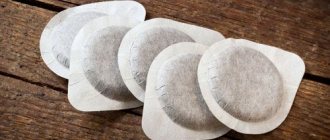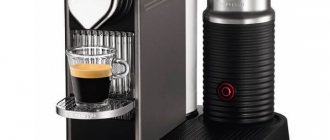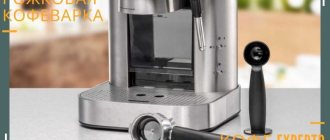Lately you can often hear about pod coffee. Someone tried it or they sell it somewhere - all these are pieces of rumors floating around. However, let's figure out together what it is and what it tastes like.
A pod or monodose is a variant of standard packaging for ground coffee. The country of origin is Italy. The purpose of creating coffee pods was to make it easier to prepare espresso at home.
In Italian, “Cialda” is translated as “tablet”. This name very accurately characterizes the appearance of the product. One cannot but agree that outwardly coffee in pods resembles a tablet.
In practice, this is a strictly verified formula for making a product:
- A portion of ground coffee is 7, and sometimes 9 grams.
- Compressed filter paper packaging.
Most often, coffee pods are additionally placed in packaging containers made of strong foil. Such packaging is necessary so that the coffee aroma does not fade over time. Carbon dioxide is pumped under the foil to protect the coffee from contact with oxygen and subsequent oxidation of the product.
Different types of such coffee, however, are packaged in a standard way - one package contains from 18 to 100 “tablets”. The very invention of coffee pods was necessary in order to standardize the process of preparing the drink, and therefore their diameter is standard - 55 or 44 mm.
You can prepare tableted coffee using specialized coffee makers and modern coffee machines. All major household appliance factories produce the corresponding equipment.
By the way, for a coffee machine you need to take pods of the diameter provided by the manufacturer. Be sure to pay attention to this when purchasing - the corresponding marking is on the packaging.
What are pods and what are their features?
The tiny packages, designed for one cup of espresso, include 2 layers of perforated paper.
There are several standards that differ in diameter, but the most common among them are:
- senseo - soft bags, not tied to a specific type;
- Easy Serving Espesso, compressed tablets (ESE)
In production, various aromatic additives are used to improve the taste. One filter bag contains 7–9 g of powder, equal to a serving of espresso . The main feature of coffee in pods is the stability of taste and a unique bouquet of aromas. They add:
- cream additives;
- caramel ingredients;
- nuts and other tasty and healthy ingredients
The spicy aroma with an almond tint of Buscaglione Long coffee pods appeals to lovers of lungo and Americano a cappuccino from the Italco Concerto bag .
Pods are usually packaged in 18, 48, 100 pieces in foil with injected carbon dioxide for maximum product safety.
But ese pods for coffee machines are suitable if the machines are compatible with this standard. These include models from the Bork, Gretti, Delonghi, Philips Saeco and other well-known brands.
This method was first used in Italy, and the pod, which translated means “wafer,” appeared on the domestic market only in 2004.
The leading manufacturers of pod machines are German companies producing Senseo models and the Netherlands, trading under the well-known Philips brand.
Appearance
The pods have a standardization system, although they may differ slightly in paper quality and shape. The diameter of coffee pods depends on the model of coffee machine for which they are intended, so special markings are placed on the packaging. ESE standard filters have a diameter of 44 mm and contain 7 g of compressed ground coffee. This amount is calculated for 60 ml of water to prepare a standard portion of espresso.
Pods according to the Senseo standard are produced in a diameter of 55 mm, which contain 9 g of crumbly coffee powder. As a rule, they are made from stronger paper that can pass up to 150 ml of water. These pods are suitable for preparing any drinks, including those with the addition of milk foam.
Each paper filter is sealed with foil, which does not allow oxygen to pass through, so that the coffee retains its original taste and aroma. Pods are sold in cardboard boxes or jars, which can contain from 18 to 100 units of goods. Thanks to the sealed packaging, they have a long shelf life, so you can stock up on this coffee for future use.
Advantages and disadvantages of pods
- ease of preparation;
- Thanks to the sealed packaging, the coffee smells like freshly ground coffee;
- you can buy pods from different manufacturers, the main thing is that the type of tablet is suitable for the coffee maker;
- when using tablets of the same brand, the quality and taste of coffee remain unchanged;
- coffee in pods is cheaper than in capsules;
- the filter paper of the bags is more environmentally friendly than the plastic from which the capsules are made;
- if a pod coffee machine is installed in a bar, it is much easier to keep track of consumed coffee;
- hygiene: throwing away a used bag is more convenient than wet, crumbling grounds, especially in an office environment;
- The filter holder does not need to be washed from grounds.
- coffee pods are more expensive than ground coffee;
- It’s difficult to change the taste or strength of coffee; to do this you’ll have to find a different brand;
- When producing coffee pods, premium beans are not used, so gourmets should not expect a particularly original taste.
Sometimes people buy a pod coffee maker for home only because it is quite cheap. But it should be borne in mind that tablets are more expensive than regular coffee, and after 1–2 years the savings will turn into losses.
When you don't have time, you can make coffee in pods. But sooner or later you will want to experiment with the taste of your favorite drink. To avoid having to buy a second coffee maker later, it is better to immediately take a closer look at “hybrid” carob models, which are suitable for both loose ground coffee and pods.
Flaws
The disadvantages of such bags are as follows:
- Unfortunately, for any coffee machine on sale there is a very meager selection of ground bean varieties. It does not exceed 15 varieties. And if they are simply not available for the model, then you will need to purchase a coffee machine for this type. A dilemma arises: buy a machine for the type of coffee or buy coffee for the machine.
- Often, the monotony of taste and the absence of a unique smell for each variety forces coffee lovers to abandon the frequent use of pods.
- Unscrupulous manufacturers may use raw materials of dubious quality.
After analyzing all the advantages and disadvantages of the production and use of such sachets, or tablets, as they are also called, you can decide to purchase them. But they are not recommended for people who like to try new varieties, feel their full, unforgettable aroma, experiment with additives in coffee, etc.
How pods are made
The production of pods takes quite a long time and occurs in several stages:
- Selection of high-quality Arabica and Robusta coffee beans. As a rule, a mixture of several types of coffee is prepared to obtain different flavor accents.
- Roasting beans (medium or high degree of roasting is used).
- Prepared grains are left for several days to interact with air to start chemical processes and preserve aromatic properties.
- The grains are ground to a powdery state.
- Ground coffee is placed in pods and sealed in gas-tight foil for 20 seconds.
Production technology - stages and nuances
The manufacturing process of packaging pods is complex and consists of several stages:
- coffee beans are prepared for processing;
- coffee is roasted;
- the finished coffee mixture is left in contact with the environment for 2 days;
- the ground grains are pressed into pods;
- The finished coffee is packaged in sealed bags with inert gas.
The last stage lasts no more than 20 seconds, as a result of which the pods come out in a perfectly round shape. Hermetic packaging allows you to preserve the quality characteristics of coffee for several years.
Types of pods
There are 3 types of pods on sale:
- ESE is the most popular standard. The inner diameter of the tablet is 44 mm, the outer diameter is no more than 55 mm. The thickness of the tablet is 10 mm, but some manufacturers may have more. The tablet is compressed, making ESE pods ideal for making espresso. The ESE standard is supported by Lavazza, Francis Francis, Innova, Nuova Simonelli, Krups, DeLonghi, Saeco, Grimac coffee makers;
- 1-2-3 Spresso – pods with a square collar and an internal tablet diameter of 40 mm, the tablet is pressed. Designed for coffee makers and coffee machines Malongo, Melitta, Salton. It is often difficult to purchase this type of pod;
- Senseo are soft pods containing crumbly ground coffee. Used in Philips Senseo, Severin, Di Maestri coffee makers. Coffee from soft pods is less strong than from pressed pods.
Features of coffee pod machines
Let's figure out what a pod coffee machine is. This is a device that prepares natural coffee at home. Among the best examples of coffee machines are the company's models:
- Philips;
- Jura;
- DeLonghi;
- Bocsh.
Grimac devices of Italian or Gretti of Chinese origin have proven themselves well. And also Melitta, Salton, Severin.
Pod coffee machines are compact, quiet in operation and easy to control. The coffee pod must be placed in the loading holder, the preparation mode must be selected on the button panel, and the unit will start. After half a minute, the drink will fill the cup, which must be placed in the desired compartment in advance.
After preparing the drink, the pod is easily removed from the equipment and the next cup is installed in the receiving compartment. There are coffee machines on sale that are designed to fill two cups at a time.
For a device of a particular brand, you should select coffee pods recommended by the manufacturer.
Tips from experts: how to choose coffee pods
Tip #1. Pay attention to the place of growth
Coffee from Costa Rica, Guatemala, and Colombia has good taste. Beans from Haiti and India have a sweet flavor. Brazilian coffee varieties have a dense taste with sour notes and a persistent soft aroma. The best varieties of Arabica are grown in Ethiopia. They make a drink of pleasant strength with a slight chocolate flavor.
- To avoid making a mistake with your choice, give preference to products from well-known companies:
- A successful combination of soft Brazilian, floral Ethiopian, tart Indian varieties.
- Soft and fairly strong coffee with a delicate chocolate aftertaste and persistent aroma.
- A blend of several varieties of highland Arabica.
- The deep, subtle taste is achieved through a unique roasting method.
- An excellent option for making espresso (75% Brazilian Arabica and 25% Alpine Robusta).
Tip #2. Particular attention to grinding degree
When purchasing, pay attention to the degree of grinding. Excellent coffee comes from medium-ground beans. The powder allows water to pass through well and is suitable for carob and pod coffee makers.
Finely ground bean pods are ideal for making espresso. In 30 seconds, the compressed tablet imparts all the taste and aroma to the drink.
Tip #3. Don't skimp on quality
You can brew good coffee from a mixture of Arabica and Robusta in a ratio of 80% to 20%. The higher the robusta content, the cheaper the pods, but the higher the strength of the drink. Pay attention to the percentage and choose a soft or bitter drink with an invigorating effect.
Tip #4. Buy coffee pods that match the type of coffee maker
Coffee machines TM Nuova Simonelli, Delonghi, Innova, Saeco, Lavazza, Grimac are oriented to the ESE standard. Soft filter bags of Senseo standards are adapted to coffee makers Severin, Philips Senseo, Di Maestri.
Tips for choosing
To buy quality coffee pods, follow the recommendations below.
Find out where the coffee beans are grown and collected. Information is indicated on the packaging. It would be good if these were the countries of South America or North Africa.
Choose pods with finely ground grains, as they allow water to pass through well and imbue it with a pleasant aroma and taste.
Don’t go for cheap prices - 10-15 rubles per pod indicates low quality coffee. The cost of a quality product starts from 25 per piece.
Types of coffee pods
The range is periodically expanded . For each coffee machine you can find up to 20 types of mixtures with different tastes. Moreover, they produce not only coffee in pods, but also tea, which differs significantly from bagged tea.
Consider popular brands on the market :
- Buscaglione . The products of this company include three types of pods of different tastes, as well as decaffeinated coffee. Buscaglione Arabica is suitable for espresso, has sweet notes and a delicate floral flavor. Buscaglione Long with sourness and almond aftertaste is suitable for lungo and Americano. The aroma is rich and spicy. Buscaglione Passione is worth taking for cappuccino and espresso; the drinks will have notes of chocolate and nuts and thick foam.
- San Giusto produces one type of blend of Robusta and Arabica. The drink based on them has a classic taste, in which the noble aroma and notes of cocoa are clearly felt.
- Italko offers two types of coffee pods. Italko Assolo contains Arabica beans from different regions. The drink has a slight sourness and fruity notes. Italco Concerto is a caffeine-rich product that has an invigorating effect. It is made from different types of Robusta with the addition of Arabica. Ideal for ristretto and cappuccino.
- Bristot is a classic espresso blend. 75% of the “coffee tablet” consists of Arabica, and the remaining 25% is Robusta. The ILLY variety of coffee is strong with a hint of bitterness and chocolate notes. Lavazza is also strong, but not bitter and has a delicate taste.
When purchasing coffee pods, choose a product made from beans sourced from Ethiopia, Colombia and Costa Rica. Coffee beans grown in Haiti have a sweetish taste. In addition to the growing region, look at the grind level. The best option is considered to be the middle fractions.
Don't take the cheapest packaging - don't skimp on quality .
Pay attention to the amount of Robusta variety in the composition - the less it is, the higher the quality and price. Select pods specifically for your coffee maker. Even a slight discrepancy will lead to the drink turning out tasteless. Equipment breakdown is also likely.
Place of growth
The process of growing a coffee tree is labor-intensive; in order to obtain high-quality beans, work on coffee plantations is mainly done by hand. The birthplace of coffee is Ethiopia; it has been consumed there since the 9th century. Over time, the growing areas of coffee trees increased and reached Central and South America, Ethiopia and southeast Asia. The production of pods includes Arabica beans from Ethiopia, which has a chocolate flavor, and coffee beans from India and Haiti, which have a sweetish taste; coffee beans from Brazil are distinguished by a slight sourness. Consistently, the most popular beans are those grown in Colombia and Costa Rica, which are distinguished by their high quality of taste.
To make coffee, all you need is a pod machine and coffee pods.
See alsoConnecting a gas stove: how to install a gas stove step by step
How to brew coffee correctly
To brew coffee you need:
– first be sure to check the presence of water in the compartment intended for this;
– then you should turn on the device;
– then you need to put the pod for the coffee machine (you already know what it is) in the compartment provided for this;
– turn on the coffee preparation mode;
– after receiving the aromatic drink, remove the used briquette and throw it away.
Be sure to use a new filter bag for a new batch of coffee. Do not skimp under any circumstances! Otherwise, the coffee will not have the declared aroma and taste. And a drink that is not your favorite will be waiting for you, something incomprehensible and tasteless.
Coffee makers for pod coffee
The first pod coffee machines were developed by the Swiss company Nespresso. Moreover, she immediately released her own line of coffee flavors. In Russia, the new product began to be produced in 2004, and it was produced by . Currently, Philips, ARIETE, Severin, GRIMAC are engaged in the production of pod coffee makers and coffee machines.
The most popular model is Philips Senseo. It is fully automated and features quiet operation, small dimensions and an affordable price.
This machine is easy to use and maintain. The only caveat is the inability to change the strength of the drink. In more expensive models there is a function for changing the drink preparation mode.
A filter bag is placed in a special tank. The water is heated to the desired temperature and pressurized through the ground coffee.
The process of preparing the drink takes no more than a minute and does not require any additional actions. There is no need to clean the device either, because the filter does not allow coffee to pass through and the tank does not get dirty.
Pod coffee has already found its fans, thanks to its undeniable advantages. It allows you to prepare the same delicious drinks as in a coffee shop without leaving your home and without any special skills. Coffee pods are definitely worth a try if you like to experiment and prefer to buy quality products at an affordable price.
Pod coffee machine: our conclusion
- Fast, clean and easy espresso preparation.
- A cup of coffee costs twice as much as ground coffee.
- The pods need to be selected according to the model of your coffee maker.
- Good coffee is prepared by pod coffee machines with a pressure of 15 bar.
- There is no point in buying cheap pod coffee makers: the coffee is watery and the pods are expensive.
- Combination coffee machines are replacing pod coffee machines.
- The best choice among the available pod coffee machines is Grimac.
Do you use a pod coffee maker? Share your impressions in the comments!
Pros and cons of pod coffee machines
The number of people who are convinced that coffee bags are of poor quality is noticeably decreasing. Well-known companies use freshly ground Arabica and Robusta beans for its production in unequal proportions and with different degrees of roasting, and also without caffeine. The mixture is packaged in a special way, and household appliance factories produce pod coffee machines based on carob models.
The popularity of filter bags is high even among fans of impeccable espresso. Thanks to precise proportions and speed of preparation, the drink turns out to have excellent taste and aroma.
Manufacturers and prices
Manufacturers of such coffee regularly expand their range. Each coffee brand has 15-29 pod coffee flavors. They differ in taste and degree of roasting.
The most popular brands of pods:
- Lavazza
- Bristot
- Buscaglione
- ILLY
- San Giusto
- Italko
The pod technology was developed by Illy
Italko produces two flavors: Concerto and Assolo. The second flavor has low caffeine content (approximately 1.2%). San Giusto is ideal for coffee lovers with chocolate notes and rich aroma. Made from Indonesian Robusta and Brazilian Arabica. The drinks made from it are strong.
Bristot is suitable for espresso. It consists of 25% Alpine Robusta and 75% Brazilian Arabica. Italco Concerto is suitable for caffeine lovers as it is very energizing. Ristretto and cappuccino are made from it. The most delicate of these is Lavazza. It has a rich aroma and no bitterness at all.
You can buy coffee in large chain hypermarkets. The price depends on the number of pods. The greater their quantity, the cheaper the packaging. For 150 pieces, on average, the price is 3,000 rubles.
Lavazza pods have a rich aroma and no bitterness at all










